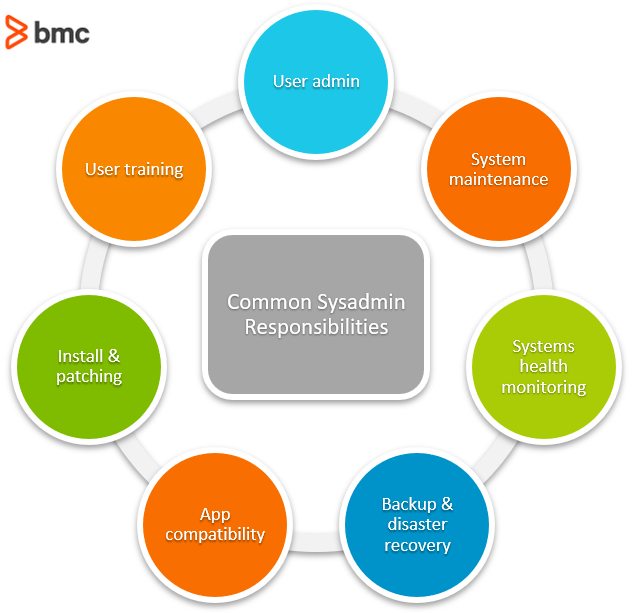Sysadmins are vital roles within every company’s IT department, often covering a wide range of technology support. Common sysadmin tasks may range from installation and deployment of servers to providing troubleshooting and technical support for projects.
If you’re reading to explore a career in system administration, you’ve come to the right place. In this article, we’ll define the role of the sysadmin job, look at roles, responsibilities, and skills, see what the salaries look like.
What is a sysadmin?
Short for “system administrator”, sysadmins are responsible for administration, management, and support activities associated with the IT infrastructure at a multi-user organization.
Responsibilities within the domain of IT systems administration can be distributed across different job titles depending on size of the organization or the scope of work required. For instance, the roles of database administrator (DBA), security administrator, and network administrator may be distinct job roles at a large enterprise but accomplished by an individual sysadmin at a smaller firm.
As a sysadmin, you’ll frequently interact with end users, through ticketing systems. You’ll respond with appropriate changes and solutions while maintaining organizational policies for issue resolution.

Sysadmin role & responsibilities
The responsibilities of a sysadmin position could include any of the following:
User administration
The primary responsibility of a sysadmin is to support reliable and effective use of complex IT systems by end users, whether internal employees or external customers. Activities range from managing identities and access to providing dedicated technical support to individual users.
As sysadmin, you may be the first contact point within IT departments for users to resolve any tech-related issue.
System maintenance
Sysadmins are responsible for dependable access and availability to IT systems. Sysadmins are therefore required to troubleshoot and fix issues that compromise system performance or access to an IT service.
This responsibility also involves regular system improvements, such as upgrades based on evolving end-user and business requirements.
Documentation
Sysadmins are required to maintain records of IT assets usage. To plan for future IT investments and upgrades, you will document:
- End-user requests
- Business requirements
- IT issues
Documentation also underpins regulatory compliance.
System health monitoring
Most IT issues go unnoticed until the impact reaches end users. Sysadmins therefore monitor system health and identify anomalous network behavior, which may include security-sensitive activities such as unauthorized network access and data transfer.
Advanced technology solutions may be used to accomplish these tasks, supporting the wider IT Security and Operations departments.
Backup & disaster recovery
Sysadmins implement data backup and disaster recovery strategies for different IT systems and SDLC environments. You’ll also facilitate end-users in accessing data that may have been deleted or unavailable.
Activities may involve:
- Implementing automated software solutions
- Replacing hardware and software components
Application compatibility
Sysadmins support various IT teams to ensure that software systems and feature releases are compatible with the IT infrastructure. For example, as sysadmin you may:
- Testing server load performance
- Install/upgrade hardware components
Web service administration & configurations
Sysadmins regularly perform web service administration and configuration management activities, including ensuring that configuration changes are documented and follow organizational policies associated with access and cybersecurity.
Configuration changes may be applied using automation and configuration management tools.
Network administration
To maintain network integrity, sysadmins ensure that network interactions follow organizational policies and protocols.
(A background in network engineering may be required to perform mission-critical network administration activities.)
Security administration
Security responsibilities are centered on infrastructure and network security, with activities including:
- Identity and access management
- Maintaining security of hardware components
- Managing software licensing, updates, and patching
Sysadmins adopting these responsibilities tend to work closely with security specialists and engineers within the organization as well as external consultants.
Database administration
Sysadmins may be responsible for maintaining the integrity, performance, and efficiency of database systems. Database management activities may include migration, design, configuration, installation and security of the organization’s data assets. Sysadmins may act as liaison with users to address database related issues, including backup and restoration activities.
Installation & patching
Sysadmins are responsible for managing, troubleshooting, licensing, and updating hardware and software assets. You will ensure that appropriate measures are proactively followed in response to unforeseen issues such as IT downtime or zero-day exploits. Then, you’ll documented these activities and follow a strategic approach, per organizational policy.
User training
Usually sysadmins communicate directly with end users to solve technical issues. Sometimes, you may also conduct training programs to bring users up to pace with new software installations or IT system changes.
These training programs may not pertain to specialized engineering tools, but the Web portal and procedures required to access the corporate network and IT services.
Common skills for sysadmins
Sysadmin positions may not require engineering know-how, but a strong background in IT is necessary to perform sysadmin duties. You’ll also want to boast effective communication skills, both written and verbal. Here are some common skills needed to be a successful sysadmin:
- Subject matter expertise. Most organizations employ multiple individuals specializing in specific system administration domains, so you’ll want to be an expert in one or more of the following:
- Computer systems
- Networks
- Hardware and software troubleshooting
- Databases
- Web services
- Problem solving. You’re often the first person called upon to deal with a problem, so troubleshooting and understanding key systems are essential.
- Strong interpersonal and communication skills, both written and verbal, as you’ll deal with technically-minded employees and non-technical colleagues alike.
Sysadmins in traditional IT departments don’t follow development and engineering responsibilities. Most modern organizations following Agile and DevOps ITSM frameworks use automation tools, infrastructure automation, and Infrastructure as a Code practices to operate IT systems. These technology solutions and practices have transformed the way infrastructure is managed and provisioned. Therefore, strong background in computer science and programming may be essential for sysadmins to succeed.
Sysadmin certifications & education
System administration is a domain of continuous learning in response to new technology release and adoption trends. Successful sysadmins therefore follow regular certification programs, which yield an average of 7.6% increase in salary.
While a Bachelor’s degree in computer science can be helpful, some industry-leading certifications and the right hands-on experience can easily supplant formal academic learning. Here are some top certifications for sysadmins:
(Explore common entry-level certifications and top-paying IT certifications.)
Sysadmin salary trends
System Administration is hard work and forms the foundation of every engineering activity in IT-driven enterprises. RedHat indicates that sysadmins in the U.S. average:
- An annual salary of $68,000 at the beginning of their career
- $81,500 for average experience and job complexity
- $115,750 for the most commanding sysadmin positions
These salaries place the sysadmin position 20th in earning potential in tech-related positions.
Related reading
- BMC Business of IT Blog
- What is a Technical Support Engineer? Explore Roles, Responsibilities, and More
- IT Director Role & Responsibilities: What Does a Director of Technology Do?
- 7 Business-Critical IT Policies & How To Implement Them
These postings are my own and do not necessarily represent BMC's position, strategies, or opinion.
See an error or have a suggestion? Please let us know by emailing blogs@bmc.com.






